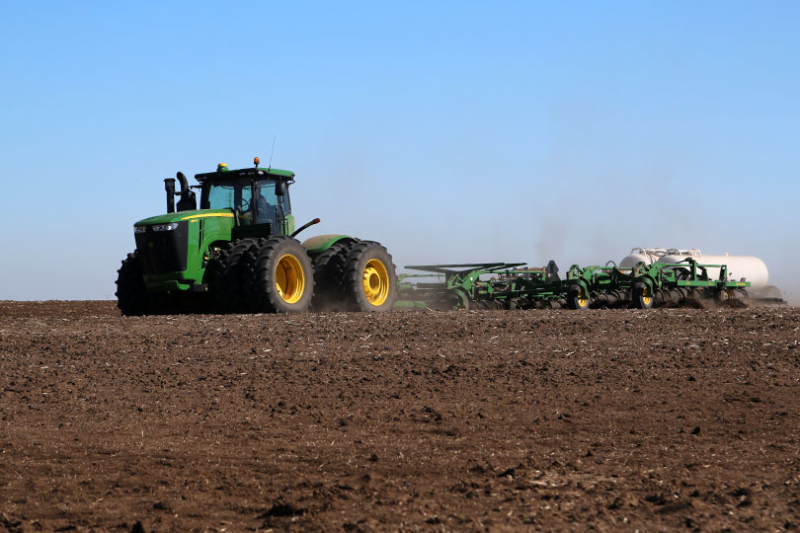By Jessica Domel
Multimedia Reporter
The U.S. Senate Judiciary Committee is examining the factors that have led to higher fertilizer and seed costs for farmers and ranchers.
“They take the risk, put in the work and feed the United States and much of the world, but they also operate on thin profit margins, if they have a profit. If input costs go up or switching suppliers is too hard, that pinch is felt by every farmer, family and consumer in the world,” U.S. Sen. Chuck Grassley (R-IA), chair of the judiciary committee, said. “Farmers across the country are shouldering significantly higher input costs, particularly for seed and fertilizer.”
Grassley, who also sits on the U.S. Senate Committee on Agriculture, Nutrition and Forestry, said competition law is about making sure the rules don’t give a few players the power to decide what everyone else pays and which choices are available.
“Nobody here wants to punish innovation,” Grassley said. “We want better yields, healthier soils, quality products, and we’ve been vastly improving in that area for the last 40 years. But we also want competition that’s fair, transparent and local competition that a farmer can actually express when he or she sits down to make a purchase.”
The chairman said over the last 20 years, a few big companies have bought up many of the smaller seed and chemical businesses.
“Those same companies now sell not just the seeds, but also the pesticides and digital farming tools that tell farmers what to plant and when,” Grassley said. “Because all these products and data systems are tied together, it’s hard for farmers to switch to a different brand. Their data and recommendations are locked in to one company’s system.”
Noah Coppess, an Iowa Farm Bureau member, told the committee farmers today are price takers, not price markers.
“That’s especially true when consolidation limits our options. It’s further complicated by the lack of price transparency with farmers forced to operate at the liberty of the market at the front and back end,” Coppess said.
He expressed concerns with input and equipment supply chains and their ability to manipulate costs.
“I recognize that consolidation can offer benefits, including cost efficiencies and technological adoption, which are critical for meeting our global food demand. However, if the market becomes too constricted, it’s ultimately the farmer who loses,” Coppess said.
Fertilizer pricing has become volatile at times, Coppess said, with “wild swings” in the market.
“Costs vary as much as 25 to 50% from year to year,” Coppess said. “We are asked to prepay for fertilizer three to six months prior to it being applied to the soil, and up to 14 months before the crop will be harvested. Many of the contracts are written with a narrow window to get the products applied or the contact expires, and the input is repriced at a higher value or monthly fees can be applied to extend the contract.”
On his farm in Iowa, they struggle with genetic options for soybean seed.
“If we want a traited seed for pesticide or disease defense, we can be at the mercy of what one company has bought from another,” Coppess said. “In effect, we are often getting genetically the same or similar hybrid from multiple companies in a different bag.”
He said they have been planting the same soybean variety for five years now due to the lack of competitive options.
Caleb Ragland, president of the American Soybean Association, told the committee for this year’s crop, farmers are paying more than ever to grow their crop.
“In just five years, seed prices have increased by 18%, fertilizer by 37%, pesticides by 25%, machinery by 23% and interest expenses by 37%,” Ragland said.
Seed is a key cost consideration for farmers, Ragland said, and advancements in seed technology have delivered real agronomic benefits, but at an added cost.
“The importance of seed quality and pesticides to crop protection means farmers cannot cut these costs,” Ragland said.
Fertilizer is also major component of overall product cost.
“Fertilizer relies on global supply chains, which makes the cost unpredictable,” Ragland said. “This is also a significant input risk that can impact the farmer’s ability to have an accurate budget.”
Corey Rosenbusch, CEO of the Fertilizer Institute, said there are over 200 producers of fertilizers globally. The U.S. is one of three countries in the world that has more than 20 unique companies producing fertilizer.
“Half of the crop yields in the world are made possible by the use of fertilizer,” Rosenbusch, who was grew up in Texas, said.
The U.S. has a significant production of nitrogen and phosphate, but only a small amount of potash.
The country imports almost 98% of our potash needs, mainly from Canada.
“The U.S. only accounts for about 7% of total global fertilizer production, and we are a net importer overall,” Rosenbusch said. “Ninety percent of all fertilizer used in the world is used outside of the United States. If you hear nothing else I say, please hear this: fertilizer is a globally-traded commodity subject to fierce global competition and supply and demand.”
China is the world’s largest producer of fertilizer with about a third of all nitrogen and 40% of phosphate, per Rosenbusch.
“They are currently restricting their exports, which are forcing growers to source those elsewhere,” Rosenbusch said. “Conflicts in the Middle East have interrupted Egyptian and North African nitrogen operations due to the natural gas supply, which is the feedstock for nitrogen, largely coming from Israel.”
Outside of those, and other, geopolitical issues impacting fertilizer prices, Rosenbusch said fertilizer demand is also up due to a larger planted acreage.
“We saw eight million additional planted acres of corn this year, which created even more demand for fertilizer,” Rosenbusch said. “Many of the largest globally-traded agricultural commodities that are experiencing price growth, thus creating higher fertilizer demand, are not even grown in the United States—such as canola, coffee and palm oil.”
He noted fertilizer production facilities are capital intensive, sometimes costing as much as $5 billion for a nitrogen facility or 10 years to develop a potash or phosphate mine.
“I do want to be very clear that fertilizer is a globally-traded commodity, so while we cannot directly influence prices, we can bolster domestic supply to help mitigate geopolitical risks for American farmers,” Rosenbusch said.
Andy LaVigne, president and CEO of the American Seed Association, said the cost associated with developing seed traits is also a factor in the cost of seeds.
“Even with this highly efficient and optimized process, it can take 8 to 10 years and several million dollars just to bring a new variety to market,” LaVigne said.
A study in 2022 estimated the cost and time to bring a new biotech trait to market at roughly $115 million and over 16 years.
Tariffs and regulations, both at home and abroad, have increased these costs.
“A tomato seed can cross six or seven different international borders for research and development before it’s sold to a farmer,” LaVigne said. “For each crossing, a tariff may be levied on that same seed, burdening the same seed producer multiple times.”
The concentration in both the seed and fertilizer markets also contributes to higher costs, Diana Moss, vice president and director of competition policy at the Progressive Policy Institute.
“Seeds and fertilizers feature highly concentrated markets with only a few firms, high prices and little choice,” Moss said. “Both sectors have been the subject of massive consolidation and strategic business practices since the last 2010s.”
She said the six large agricultural biotechs merged to form the big three.
Today, two firms control 72% of the corn seed market and 66% of the soybean market.
Three firms control 83% of the cotton seed market.
“Highly concentrated markets are far more conducive to anti-competitive coordination rather than the hard-nosed competition that lowers prices, lowers licensing fees, tech fees and royalty rates,” Moss said.
In the last 30 years, the average price farmers paid for genetically-modified seed rose by almost 450%, Moss said, while commodity prices rose by only 50%.
Fertilizer prices spiked in 2008, 2012 and 2022.
“All of this puts the squeeze on farmers’ margins,” Moss said.
She said the committee may consider giving the U.S. Department of Agriculture the authority to intervene if consolidation raises supply chain safety, stability and resiliency issues with farmers.
“We should also be very worried that high concentration costs, prices and a lack of choice risk the permanent loss of U.S. agricultural productive capabilities if farmers hang up their hats and close down their farms,” Moss said.
Grassley outlined four points he believes may help farmers, including the need for transparency in input costs.
“Farmers deserve to know the effective price they’re paying, including how rebates and clawbacks really work, and whether wholesale fertilizer declines are being passed through in a timely way,” Grassley said.
The second point is portability.
“Farmers ought to control their own data and move it quickly, completely and affordably so they can seek independent agronomic advice without fear of losing their history,” Grassley said.
The third point is fair dealing contracts and dealer programs should not operate as defector exclusive arrangements in rural counties where there might only be one or two full service outlets.
Grassley also pushed for accountability, his fourth point.
“When mergers don’t deliver what was promised on paper, agencies should look back and fix it,” Grassley said.


Leave A Comment